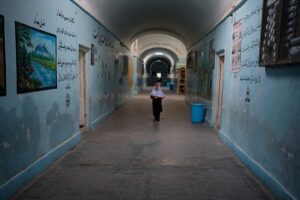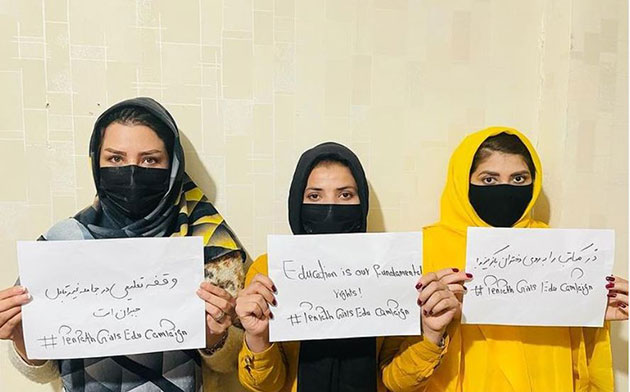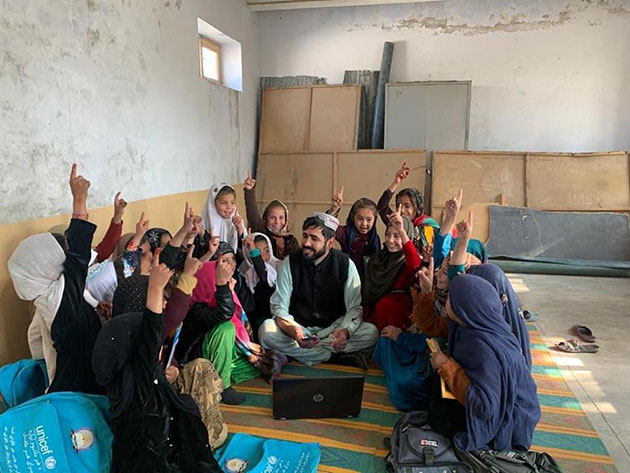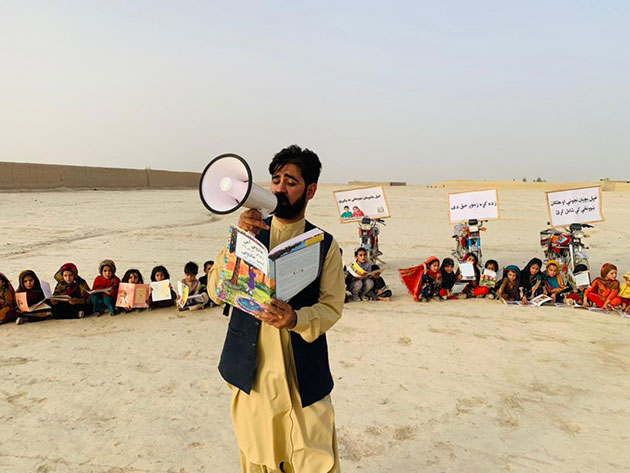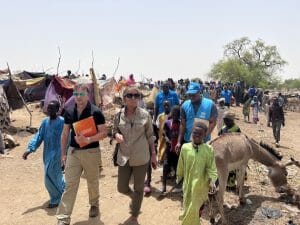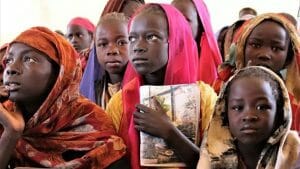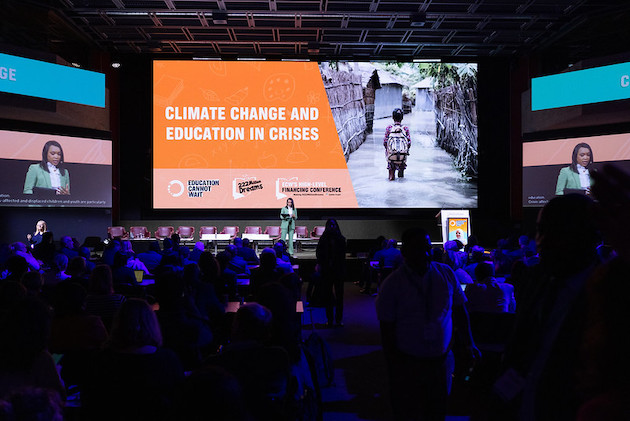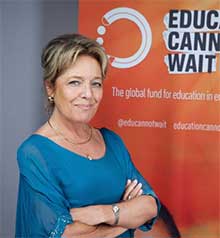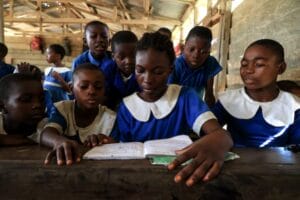
Active Citizens, Child Labour, Civil Society, Development & Aid, Editors’ Choice, Education Cannot Wait. Future of Education is here, Gender, Global, Headlines, Health, Human Rights, Humanitarian Emergencies, Population, Sustainable Development Goals, TerraViva United Nations, Youth
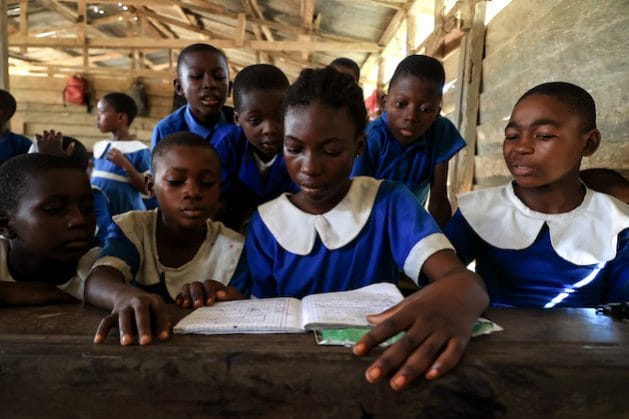
Students attending class at the Souza Gare school in the Littoral region, Cameroon. The school hosts displaced children who have fled the violence in the North-West and South-West regions.
Credits: ECW/Daniel Beloumou
– Inclusive social protections for children would be a positive signifier of social development in a time where 1.4 billion children globally are denied them. A step towards realizing this has been taken through a new monitoring tool on current social protection and child poverty statistics.
The International Labour Organization (ILO), UNICEF, and Save the Children have partnered together to create the Global Child Benefits Tracker. This online platform will globally monitor children’s access to social protection and identify gaps in existing social protections systems in over 180 countries.
On Wednesday, this tool was launched at a side event on universal child benefits (UCBs) during the 62nd Commission for Social Development (CSoCD62) hosted in New York. One of the prevailing themes for this year was the use of digital transformation to promote inclusive growth and development. In the context of the Sustainable Development Goals, the tracker would go forward to monitoring growth in poverty eradication by calling on governments to implement responsible and appropriate social protection systems for all by 2030.
The platform includes a breakdown of child poverty statistics by country, region, and income bracket. Notably, the percentage of children that currently have access to social protections is higher when compared to the percentage of the country’s population that is covered by benefits and the expenditures on these social protections. The platform also provides data on the percentage of children at risk of or experiencing monetary or multidimensional poverty. The purpose of this platform will be to serve as a knowledge tool for use in designing evidence-based child-sensitive social protections, intended for use by policymakers in government and international development programmes, social protection programmes, and civil society organizations. The tool would facilitate the exchange of best practices and inspire greater investment in child-sensitive social protection.
The platform also includes a community tab, where supplemental material can be shared as designed by experts and practitioners, such as blog posts, podcasts, videos, and links to resources. David Lambert Tumwesigye, the Global Policy & Advocacy Lead, Child Poverty, of Save the Children International, has urged members of government, academia, development partners, and practitioners to contribute to the community tab and expand the broader understanding of child poverty. “We aim to highlight the scale of global child poverty,” he said.
Disruptions in the global economy, increased costs of living, and the COVID-19 pandemic are cited as some of the factors that have underlined the need for resilient and comprehensive social protections, especially for children at high risk of experiencing poverty. Yet, as was pointed out by speakers at the event, there have been limited investments in social protections for children, despite the general sentiment that these would be imperative. This was described as a “moral, social, and economic catastrophe,” by ILO Director in New York, Cynthia Samuel-Olonjuwon.
At the launch of the International Labour Organization (ILO), UNICEF, and Save the Children’s Global Child Benefits Tracker. Credit: Naureen Hossain/IPS
“Life without social protection inflicts enormous social costs, and they result in squandered and prematurely shortened lives,” she said. “For children, social protection can literally be a lifesaver. It can make the difference between a healthy, happy, and long life or one that is punctuated by ill health, stress, and unrealized potential.”
The data on countries’ current social protections has been compiled through public studies and those conducted by the ILO and UNICEF. It reveals that social protection programmes in low-income countries reach less than 10 percent of their child population, in contrast to high-income countries, where their programmes reach more than 80 percent of their child population. Yet, the global average of children covered by social protection or benefits caps out at 28.1 percent. Although the evidence suggests that low-income countries struggle to provide universal child benefits, child poverty is still a global issue that affects all countries, regardless of their income group.
ILO, UNICEF, and Save the Children have urged policymakers and leaders to take the necessary measures to implement universal child benefits, or at least more inclusive, child-sensitive social protections. This includes building a social protection system that provides benefits to its citizens across the life cycle, from birth to old age, and securing financing for these programmes through increased public investments and mobilizing domestic resources.
A comparison of child benefits in South Africa compared to the region. Credit: Child Benefits Tracker
The Global Child Benefits Tracker may be a step forward in monitoring progress towards social development when considering the progress that remains in achieving the SDGs. While it is still in its early days, the tool may benefit from expanding its coverage to include contributions from actors on the ground. Philip Alston, the former UN Special Rapporteur on Extreme Poverty and Human Rights, suggested that the platform should include qualitative evidence through testimonies to get a clearer sense of the challenges that hinder social protections and how governments have chosen to act.
There will remain challenges to implanting the sort of social protections and benefits that are being called for. There are still gaps in information, as not all countries are featured. At present, there is limited investment in child benefits. It was acknowledged that the fiscal space is a determining factor, and for the low- and middle-income countries in the Global South, this can be even more challenging due to the limitations in their financial state. It is here that solidarity from the international community and support from financing institutions would serve these countries.
Child benefits can be part of the wider social protection systems, and it has been proven that they can positively contribute towards food security and improved access to basic social services, according to UNICEF’s Global Director of Social Policy and Social Protection, Natalia Winder Rossi. Not only can they directly benefit children and their families, but they can also contribute to their communities and local economies.
“The investment is clear, the evidence is clear, but we continue to face challenges in convincing our own policymakers that this is a wide choice,” she said. “I think the Tracker provides some of that progress, to track some of those results… At UNICEF, this is part of our very strong commitment to closing the coverage gap for children. To make sure that we have systems that are strong and inclusive, we must make sure that every child is part of them and receives adequate benefits. But also that systems are adequately responding to crises.”
Visit the Global Child Benefits Tracker here.
IPS UN Bureau Report

